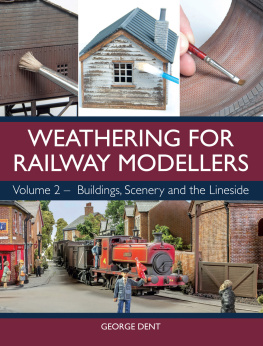Gypsies, Preachers
AND
Big White Bears
One Hundred Years on Country Roads
CLAUDIA SMITH


GENERAL STORE PUBLISHING HOUSE INC.
499 OBrien Road, Renfrew, Ontario, Canada K7V 3Z3
Telephone 1.613.599.2064 or 1.800.465.6072
http://www.gsph.com
ISBN 978-1-896182-91-7 (Pbk)
978-1-77123-809-0 (EBUB)
978-1-77123-810-6 (MOBI)
978-1-7123-811-3 (PDF)
Copyright Claudia Smith 2014
Cover art, design: Magdalene Carson
Published in Canada.
No part of this book may be reproduced, stored in a retrieval system, or transmitted in any form or by any means without the prior written permission of the publisher or, in case of photocopying or other reprographic copying, a licence from Access Copyright (Canadian Copyright Licensing Agency), One Yonge Street, Suite 800, Toronto, Ontario, M5E 1E5.
Cataloguing data available at Library and Archives Canada
For A.J. Mckay
who shared his stories of days long passed as well as his love of history.
And felt the hillside thronged by souls unseen
John Masefield
Contents
INTRODUCTION
This book records the activities on the country roads from pioneer days to the early days of cars. It celebrates rural life by chronicling the traffic and travellers who formed the colourful ribbon of commerce and society that wound through the countryside over the years.
The research material was ten years in the gathering. Chance comments about gypsies put me on the trail of Lanark Countys colourful history. I interviewed many senior citizens who shared their memories with me and to whom I am most grateful. Their recollections of stories, handed down from long ago, made scenes of life in the forests, fields, log houses and cow byres flicker and form in my minds eye. I have also scoured old diaries, scrapbooks, letters, newspapers and township records. Being affiliated with the Middleville and District Museum as a volunteer gave me access to many papers and photograph albums and a vast collection of Ontario statute books.
Chapter 1
Breaking Trail
F orests, dark and impenetrable, covered the rocky hills and fertile stretches of Lanark County before white settlers came to begin new lives in a new land. The shadowed depths under virgin pines, oaks and maples were threaded only by a few well-worn Indian trails.
When the pioneers arrived, they had to hack rough, two-tracked paths through the dense forests. Many, many hard years passed before the country folk could travel on smooth roads and look out over cultivated fields. The action and drama on the roads during the years of development provide a window into the history of the land.
In the British Isles of the early 1800s, employment was at a premium. There was an urgent need for places of settlement for the penniless workers displaced by the Industrial Revolution. Many soldiers were destitute and unemployed as well, due to the lull in the Napoleonic War and the end of the War of 1812 with the United States. The impoverished people had few choices and starvation drove the people out of their native land. In Lanarkshire, Scotland, at the Christmas season of 1819, in parish after parish, Scotsmens families could not attend their kirk for want of clothing. Plans for the settlement of Eastern Ontario moved on the wings of this desperation.
Great numbers of the discharged soldiers as well as mechanics, labourers, and weavers accepted offers of free passage, land grants, rations and implements from their government to begin new lives. Scottish Settler Societies also aided in the emigration of many poverty stricken people. Given this opportunity, the settlers had a chance to become independent. Through their own industry and courage they could make a fresh start, free of grasping landlords and relentless tax gatherers. Thousands of society settlers took the challenge and braved the rugged sea voyage in the full rigged sailing ships of the early 19th century. The trip was one of crowded discomfort, hunger and desperate illness. Many perished at sea. Cholera, dysentery and chincough or whooping cough took a severe toll before the ships reached the ports of Quebec City or Montreal.
Those who survived the voyage across the Atlantic struggled with flagging energies to move their possessions and families into small boats to travel up the St. Lawrence River toward Upper Canada. The immigrants helped pull the boats up savage rapids and slept in the open each night of the trip. They had to stay on guard constantly against being robbed or overcharged for any services that their guides offered.
During the early years of the 1820s, large groups of Scottish and Irish travellers arrived in Prescott. From there, arrangements were made with ox drovers or teamsters with hardy horses to transport their families and their few worldly goods. For many, their destinations were the newly opened townships of The District of Bathurst, which later became Lanark County.
There was a rough track laid out from Prescott to Perth and the history of the highways and byways of Lanark County began when these settlers made their way through the wilderness. People, young and old, who were used to the city streets and country roads of their homeland, arrived in a wild and unsettled land. Could they ever have imagined such an inhospitable place? James Gilmour, a Scottish immigrant of 1820 wrote to his brother back in Glasgow simply stating, The want of roads is the greatest evil.
Another newcomer, Andrew Bell, penned this report home, We were three days on our journey between Prescott and Perth We thought the land would be covered with grass, and only a few trees here and there. But how great was our disappointment, when we found the ground was all covered with large trees, and not a pile of grass growing, except in beaver meadows .
The trails hacked through the forest were practically impassable. In a days journey of approximately forty miles, much of the way was made over roads crosslaid with tree trunks in the many boggy and swampy places. With the size of these rough logs ranging from nine inches to two feet in diameter, the road surface was very uneven.
These famous corduroy roads were named for their resemblance to the hard-wearing ridged cloth. [Their] only merit was that a cart could get across the swamp on it, but if the driver went too quickly his vehicle threatened to fall apart from the terrible jolting or his horses hoofs might be trapped between timbers.
The miserable crosslayed causeways of 1823 were described by British traveller, Edward Talbot, in this wry way:
As these logs are neither square nor are they flattened, and not always perfectly straight, they frequently lie so far apart, that horses, cows, and oxen are continually in danger of breaking their limbs in passing over. Cattle of all kinds in this country are so accustomed thus to dance upon beech and maple, that, before they attain their second year, they acquire such proficiency in the art of log-walking, that I should not be at all surprised to hear of a horse or bull becoming a rope-dancer.


















